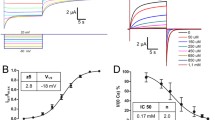Abstract
Gap junction channels are regulated by gates that close upon exposure to 100% CO2, probably via an increase in intracellular Ca2+ concentration, [Ca2+]i. For denning connexin (Cx) domain(s) involved in gating, we have studied chemical and voltage gating sensitivities of channels made of Cx38, Cx32 or chimeras of the above, expressed in Xenopus oocytes. Cx38 channels are more sensitive to CO2 and voltage than those of Cx32. A 3-min exposure to 100% CO2 reduces Cx38 junctional conductance (Gj) to 0% of initial values at a maximum rate of 25 %/min, whereas even a 15-min exposure to 100% CO2 reduces Cx32 Gj by approximately 50% at the slow rate of 9%/min. Of the various Cx32 mutants and Cx32/38 chimeras constructed, two chimeras (Cx32/38I and Cx32/38N) expressed functional channels. Upon exposure to CO2, channels made of Cx32/38I (Cx32 inner loop replaced with that of Cx38) reproduced precisely the uncoupling behavior of Cx38 channels in uncoupling magnitude and in both uncoupling and recoupling rates, whereas channels made of Cx32/38N (N-terminus replaced) behaved closer to Cx32 than to Cx38 channels. Cx38 channels were more voltage sensitive than those of Cx32, with V0, i.e., the transjunctional voltage at which voltage-sensitive conductance is half maximal = 35.3 and 59.5 mV, and n, i.e., equivalent gating charge =3.3 and 2.1, respectively. Of the two chimeras, Cx32/38I channels were similar to Cx38 channels, with V0 = 40.6 mV, Gj min, i.e., the theoretical minimal normalized junctional conductance = 0.35 and n = 3.0, whereas Cx32/38 N channels displayed very low voltage sensitivity, with V0 = 84.8 mV, Gj min = 0.5 and n = 1.1. The data suggest that the inner loop plays a major role in pH and voltage gating sensitivity, but whether other domains also participate in the gating mechanism cannot be excluded.
Similar content being viewed by others
References
Barrio LC, Suchyna T, Bargiello T, Xu LX, Roginski RS, Bennett MVL, Nicholson BJ (1991) Gap junctions formed by connexins 26 and 32 alone and in combination are differently affected by applied voltage. Proc Natl Acad Sci USA 88: 8410–8414
Bennett MVL, Barrio LC, Bargiello TA, Spray DC, Hertzberg E, Sáez JC (1991) Gap junctions: new tools, new answers, new questions. Neuron 6:305–320
Beyer EC, Paul DL, Goodenough DA (1990) Connexin family of gap junction proteins. J Membr Biol 116:187–194
Bruzzone R, White TW, Paul DL (1994) Expression of chimeric connexins reveals new properties of the formation and gating behavior of gap junction channels. J Cell Sci 107:955–967
Ebihara L, Beyer EC, Swenson KI, Paul DL, Goodenough DA (1989) Cloning and expression of a Xenopus embryonic gap junction protein. Science 243:1194–1195
Ek JF, Delmar M, Perzova R, Taflet SM (1994) Role of histidine 95 on pH gating of the cardiac gap junction protein connexin43. Circ Res 74:1058–1064
Harris AL, Spray DC, Bennett MV (1981) Kinetic properties of a voltage-dependent junctional conductance. J Gen Physiol 77:95–117
Lazrak A, Peracchia C (1993) Gating sensitivity to physiological calcium regardless of pH and single channel activity in gap junctions of Novikoff hepatoma cells. Biophys J 65:2002–2012
Liu S, Taflet S, Stoner L, Delmar M, Vallano ML, Jalife J (1993) A structural basis for the unequal sensitivity of the major cardiac and liver gap junctions to intracellular acidification: the carboxyl tail length. Biophys J 64:1422–1433
Methfessel C, Witzemann V, Takahashi T, Mishina M, Numa S, Sakmann B (1986) Patch clamp measurements on Xenopus laevis oocytes: currents through endogenous channels and implanted acetylcholine receptor and sodium channels. Pflügers Arch 407:577–588
Paul DL (1986) Molecular cloning of cDNA for rat liver gap junction protein. J Cell Biol 103:123–134
Peracchia C (1988) The calmodulin hypothesis for gap junction regulation six years later. In: Hertzberg EL, Johnson RG (eds) Gap junctions. Liss, New York, pp 267–282
Peracchia C (1990) Increase in gap junction resistance with acidification in crayfish septate axons is closely related to changes in intracellular calcium but not hydrogen ion concentration. J Membr Biol 113:75–92
Peracchia C (1990) Effects of caffeine and ryanodine on low pHi-induced changes in gap junction conductance and calcium concentration in crayfish septate axons. J Membr Biol 117:79–89
Peracchia C, Lazrak A, Peracchia LL (1994) Molecular models of channel interaction and gating in gap junctions. In: Peracchia C (ed) Handbook of membrane channels. Molecular and cellular physiology. Academic Press, San Diego, pp 361–377
Peracchia C, Wang X, Li L, Peracchia LL (1995) Inhibition of calmodulin expression prevents low pH induced gap junction uncoupling in Xenopus oocytes. Pflügers Arch 431:379–387
Rubin JB, Verselis VK, Bennett MVL, Bargiello TA (1992) A domain substitution procedure and its use to analyze voltage dependence of homotypic gap junctions formed by connexins 26 and 32. Proc Natl Acad Sci USA 89:3820–3824
Sambrook J, Fritsch E, Maniatis T (1989) Molecular cloning. Cold Spring Harbor Laboratory Press, Cold Spring Harbor, New York
Spray DC, Burt JM (1990) Structure-activity relations of the cardiac gap junction channel. Am J Physiol 258:C195-C205
Spray DC, Harris AL, Bennett MV (1981) Equilibrium properties of a voltage-dependent junctional conductance. J Gen Physiol 77:77–93
Verselis VK, Ginter CS, Bargiello TA (1994) Opposite voltage gating polarities of two closely related connexins. Nature 368:348–351
Werner R, Levine E, Rabadan-Diehl C, Dahl G (1991) Gating properties of connexin32 cell-cell channels and their mutants expressed in Xenopus oocytes. Proc R Soc lond [Biol] 243:5–11
Willecke K, Heynkes R, Dahl E, Stutenkemper R, Hennemann H, Jungbluth S, Suchyna T, Nicholson BJ (1991) Mouse connexin37: cloning and functional expression of a gap junction gene highly expressed in lung. J Cell Biol 114:1049–1057
Author information
Authors and Affiliations
Rights and permissions
About this article
Cite this article
Wang, X., Li, L., Peracchia, L.L. et al. Chimeric evidence for a role of the connexin cytoplasmic loop in gap junction channel gating. Pflügers Arch. 431, 844–852 (1996). https://doi.org/10.1007/s004240050076
Received:
Revised:
Accepted:
Issue Date:
DOI: https://doi.org/10.1007/s004240050076




